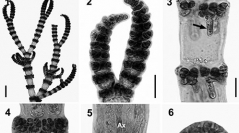

 Cryptogamie, Algologie
25 (4) - Pages 397-407
Cryptogamie, Algologie
25 (4) - Pages 397-407In studying the morphology and reproductive development in two species of Ceramium (Ceramiaceae, Rhodophyta), with emphasis on nodal cortication, two different developmental patterns of rhizoidal corticating cells were found. In C. personatum (a species with incomplete cortication), elongate rhizoidal corticating cells are only produced basipetally from periaxial cells at the nodes, whereas in C. nitens (a species with complete cortication), they are produced both acropetally and basipetally from periaxial cells and function as inner cortical cells producing the outer cortical cell clusters throughout the thallus. The rhizoidal corticating cells of C. personatum typically resemble those of C. californicum, while those of C. nitens resemble those of C. boydenii. The female reproductive structures of C. personatum, reported here for the first time, conform to those of other known species of Ceramium. Some species, such as C. nitens, have rhizoidal corticating filaments and complete cortication, a characteristic of Campylaephora; however, these taxa can be distinguished by separated cortication between distal and proximal axial cells of the former versus Campylaephora, which has secondary pit-connections between the rhizoidal corticating cells. Our findings support the critical need for a revision of the genera Ceramium and Campylaephora.